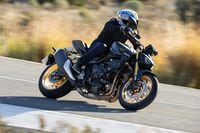Sport motorcycle design and the technology upon which bikes are built have improved with impressive consistency. Starting back in the early 1980s, the factories embarked on a path of creating sportbikes that have grown ever closer to full-race specification.
Compare 2012 600cc Supersport lap times to a factory 1998 750cc Superbike running at Phillip Island in Australia—a track which requires both horsepower and technical skills. The near-stock 600s this year were a full second quicker than the fastest full-on Superbikes back then, and equal to the first year of the 1000cc Superbikes in ’03—less than 10 years ago.
It seems only logical that riding techniques would change as much as the bike technology has, but is that true? The evolution in tire technology has been huge. But is traction so good now that riders can ignore its limits? Has the increase in traction for braking, cornering or acceleration eliminated those limits, such as lean angle, that govern them? Have racing lines changed substantially over the past 15 or even 30 years? Does having higher corner entry, middle and exit speeds from better tires make it easier to find the right lines? Were riders able to run precision lines on the old bike/tire combinations?
Bikes are narrower now than they used to be, giving better cornering clearance. Can today’s rider ignore the bike’s lean-angle limits? Is the rider’s knee on the ground giving different information?
Electronics have changed the face of bike tuning and adjustment. But have they eliminated the need for good riding technique?
The answer is no. Technology has not substantially changed rider skills. The recent major change—electronic traction control—simply allows for safer and more consistent corner-exit drives.
A rider can change the speed and direction of his motorcycle. The modern motorcycle will do both better than ever before. Good riding, however, is what gets those changes made at the right place, at the right time, and to he correct degree. The simple conclusion is that the need for rider awareness and control hasn't changed in the most important areas. The technology of riding remains solidly in place.
Modern motorcycle technology provides better integrated transitions between those changes. The beginning, any adjustment and the completion of each control input can now be done with improved sensitivity. Things don’t happen so abruptly now due to substantial increases in usable control range for chassis, suspension, brakes and engine components.
Actions flow better now: quicker, cleaner gear changes; more progressive power with both the engine and the brakes; more precise control of wheel movement through more of the suspension stroke; more complimentary frame and swingarm rigidity.
Being better able to integrate our control inputs makes for a more connected feel to the motorcycle. We do have better traction and line-holding potential, but that potential does not eliminate the skills necessary to use it.
In the not-so-old days, aggressive riding was difficult to do smoothly. It took real finesse; our control timing and transitions had to be better planned and very carefully executed. The rider was more responsible for integrating all control transitions. As a result of the new bike tech, there is more latitude when pushing it. The point here is the essentials of what we are pushing—lines, traction, lean and speed—remain the same.
In the case of a less experienced rider, the forgiving nature of new equipment covers up quite a few errors. For the already good rider, it broadens what used to be a much finer line between in-control and out-of-shape.
Going fast while maintaining control is still a precarious balancing act between bike and rider. The one thing that stands above all the other benefits we derive from new technology is the huge savings in attention that all those advancements have provided us. Before, it required extraordinary focus and timing to ride a bike. Today, new-tech bikes let us re-focus our attention, allowing for more of it to be spent on taking advantage of their potential. MC











/cloudfront-us-east-1.images.arcpublishing.com/octane/2WF3SCE3NFBQXLDNJM7KMXA45E.jpg)
/cloudfront-us-east-1.images.arcpublishing.com/octane/G4MG6OUCJNBSHIS2MVVOTPX65E.jpg)
/cloudfront-us-east-1.images.arcpublishing.com/octane/IIGGWFOTOJGB7DB6DGBXCCMTDY.jpg)
/cloudfront-us-east-1.images.arcpublishing.com/octane/QSTCM6AVEZA5JJBUXNIQ3DSOF4.jpg)
/cloudfront-us-east-1.images.arcpublishing.com/octane/U4I7G625B5DMLF2DVIJDFZVV6M.jpg)
/cloudfront-us-east-1.images.arcpublishing.com/octane/B6XD6LS6IVCQPIU6HXDJSM3FHY.jpg)
/cloudfront-us-east-1.images.arcpublishing.com/octane/ICL63FEDDRDTTMINYICCEYGMDA.jpg)
/cloudfront-us-east-1.images.arcpublishing.com/octane/FCGZHQXRBZFLBAPC5SDIQLVF4I.jpg)
/cloudfront-us-east-1.images.arcpublishing.com/octane/WNOB6LDOIFFHJKPSVIWDYUGOPM.jpg)

/cloudfront-us-east-1.images.arcpublishing.com/octane/X33NU3E525ECRHXLNUJN2FTRKI.jpg)
/cloudfront-us-east-1.images.arcpublishing.com/octane/6KKT5NNL2JAVBOXMZYS5ZO76YA.jpg)
/cloudfront-us-east-1.images.arcpublishing.com/octane/J5RKG5O455GMPGQRF2OG6LRT7A.jpg)
/cloudfront-us-east-1.images.arcpublishing.com/octane/GX2CIZKQVRH2TATDM26KFG2DAE.jpg)
/cloudfront-us-east-1.images.arcpublishing.com/octane/ZWIDYSAKQZHD5BHREMQILXJCGM.jpg)
/cloudfront-us-east-1.images.arcpublishing.com/octane/CYUHJZCTSJCH3MRAQEIKXK7SCQ.jpg)
/cloudfront-us-east-1.images.arcpublishing.com/octane/LKOFINY56FCXJCANJ5M7ZDQUBY.jpg)
/cloudfront-us-east-1.images.arcpublishing.com/octane/4NBPDACMWJH63JQYJVK3QRBDZI.jpg)
/cloudfront-us-east-1.images.arcpublishing.com/octane/KKHQHRR3FJGX7H2IPU6RALMWG4.jpg)

/cloudfront-us-east-1.images.arcpublishing.com/octane/5IOFS5JAE5FOXMNA23ZRAVVYUU.jpg)
/cloudfront-us-east-1.images.arcpublishing.com/octane/CGXQ3O2VVJF7PGTYR3QICTLDLM.jpg)

/cloudfront-us-east-1.images.arcpublishing.com/octane/OQVCJOABCFC5NBEF2KIGRCV3XA.jpg)